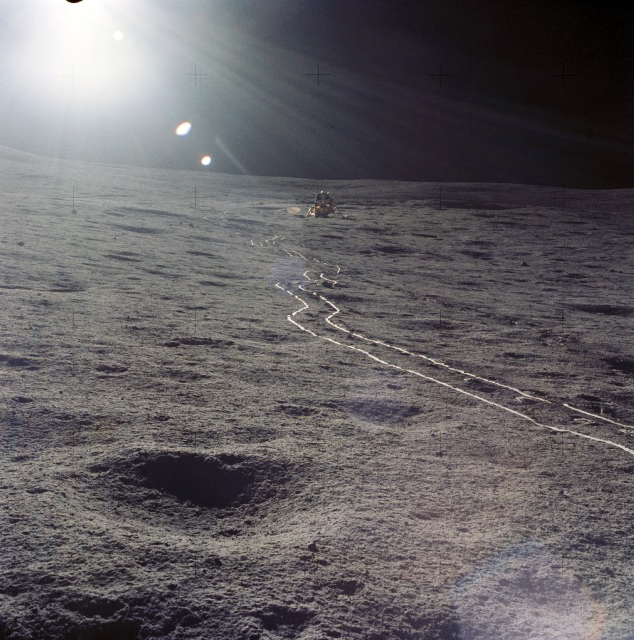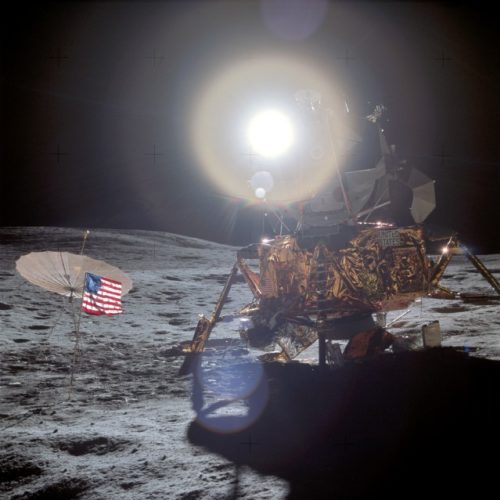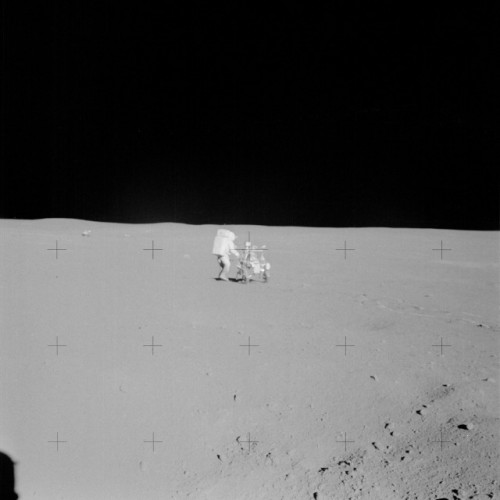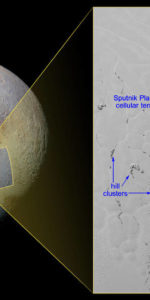
Forty-five years ago, last week, the sixth team of Apollo lunar explorers—and only the third to accomplish a landing on the Moon’s dusty surface—headed back to Earth after a mission which restored confidence in America’s space program after the near-disastrous Apollo 13. Astronauts Al Shepard, Stu Roosa and Ed Mitchell brought a scientific yield back home which illustrated that the Moon was a far more complex celestial body than previously believed. As outlined in last weekend’s AmericaSpace history articles, the mission of Apollo 14 itself was extraordinarily complex, but it was also a very human story of one man’s battle against almost impossible odds to regain flight status, a story which carried more than its fair share of highs and lows…and the story of the Moon’s first golfer.
In the early hours of 5 February 1971, five days since leaving Pad 39A at the Kennedy Space Center (KSC) in Florida, Shepard and Mitchell brought their Lunar Module (LM), named “Antares”, to a smooth touchdown in the Moon’s hummocky Fra Mauro foothills, as Roosa orbited overhead in the Command and Service Module (CSM), dubbed “Kitty Hawk”. It had not been a perfect descent, having been marred by problems with Antares’ critical landing radar, which almost caused the mission to be aborted. In the first few minutes after touching down on the Moon, Mitchell turned to Shepard and asked him if he would really have aborted the mission if the radar had not locked-on in time.
Shepard grinned. “Ed,” he said, “you’ll never know!”
Earlier, when Capcom Fred Haise had advised him to consider looking over the abort procedures, Shepard responded, with clear sarcasm in his voice, that he was well aware of the rules. Knowing Shepard as everyone did, it seems more than likely that after ten years waiting for this opportunity to land on the Moon, he would have rewritten the mission rules on the spot: As long as the vehicle continued to fly beautifully and everything else seemed to be going well, he would have attempted to land, even without the aid of the radar. In fact, in his memoir Moon Shot, co-authored with Deke Slayton, he wrote that, with the future of Apollo hanging by a thread, there was no alternative but to land.

Others were more skeptical. In his autobiography, Failure Is Not An Option, Flight Director Gene Kranz recalled the feelings of fellow Flight Director Gerry Griffin and his team. “On Apollo 14,” he wrote, “the error in the LM computer’s knowledge of the actual altitude was almost 4,000 feet (1,200 meters) before the landing radar data update. With an error this great in the computer, Griffin and the [flight controllers] were convinced Shepard would have run out of fuel before landing. But everyone who knew Al never doubted he would have given it a shot. We also never doubted he would have had to abort. The fuel budget was just too tight.”
Early on 5 February 1971, it was a moot issue. Shepard and Mitchell had become the third team of human lunar explorers to make landfall on the Moon. Glancing at the bright, undulating terrain of Fra Mauro beyond Antares’ triangular windows, both men reported that it was considerably more rugged than Tranquility Base or the Ocean of Storms, which had earlier been visited by Neil Armstrong and Pete Conrad’s crews. There was certainly more topographical relief, Mitchell added, than they had anticipated by looking at their maps. Even before they ventured outside, a key obstacle of operating on the Moon was apparent: The complete absence of any recognizable features made it incredibly difficult to judge distances. Indeed, Shepard and Mitchell would come face to face with this problem during their second Moonwalk. The lack of a sensible atmosphere lent an unreal clarity to the scene, and the horizon seemed to slope noticeably away from them, framed by a totally black sky. Unlike Earth, they could actually sense that they were on a spherical body.
Just under five hours later, at 8:54 a.m. EST, after abandoning plans to take an early rest period, Shepard dropped down onto the surface of that spherical body and planted his boots into lunar soil. The importance of first words had been on everyone’s mind, it seemed, even as Neil Armstrong prepared for Apollo 11, and the need to prove a point and win a bet had been Conrad’s primary motivation for what he had said on Apollo 12. In Shepard’s case, however, a dozen years since joining the astronaut corps and after the better part of a decade spent chained to a desk, his words were profound for a different reason: for they reflected the end of a long and difficult journey. Not only had he beaten Ménière’s Disease, not only would he become the only one of the Original Seven Mercury astronauts to set foot on the Moon, but he had overcome all the odds in being able to fly again. Clinging tentatively onto Antares’ ladder, he turned and looked out onto the barren landscape and an eerie silence of ages, all around him.
“It’s been a long way,” he said, wonder evident in his voice, “but we’re here.”
Moving around the lander, he gazed to the east and could clearly see the ridge which he and Mitchell would attempt to negotiate the following day to reach the 1,000-foot-diameter (300-meter) Cone Crater, whose depth was thought to reach about 250 feet (76 meters). The entire Fra Mauro region was believed to have been formed by ejecta from the impact which created the enormous (and ancient) Mare Imbrium (Sea of Rains), in the Moon’s northwestern quadrant. It was hoped that by finding and gathering samples from Cone, the astronauts might be able shed new light on the nature of the impact, estimates of whose age range between 3 billion and 4.5 billion years old.

For now, though, Mitchell himself was itching to get outside. With both men on the surface, they began assembling the customary Stars and Stripes, the erectable S-band antenna, the solar wind composition experiment, a rickshaw-like tool carrier known as the Modular Equipment Transporter (MET), and the Apollo Lunar Surface Experiments Package (ALSEP). For the latter, they picked a spot to the west of Antares, setting up the nuclear-powered central station, from which radiated, in a star-like formation, its five main research instruments: the passive and active seismic experiments, which were designed to acquire data about the physical properties of the lunar crust, together with a cold cathode gauge to monitor the density of the Moon’s atmosphere, a suprathermal ion detector to measure the composition of its ionosphere, and a charged-particle detector to study the solar wind impinging on the lunar surface.
Of these, the active seismic device is particularly notable, since it required the implantation of three “geophones” onto the surface, in a straight line at distances of 10 feet (three meters), 165 feet (50 meters), and 330 feet (100 meters) from the ALSEP’s central station. These provided a sort of mechanical “ear,” which Mitchell activated using a “thumper” to produce a series of artificial quakes. “Earlier lunar seismic experiments,” Time magazine told its readers on 1 February, “have been largely passive; that is, the seismometers have usually depended on the occurrence of Moonquakes or other natural rumblings to make readings.” Now, with the help of the thumper, not dissimilar in shape to a heavily-weighted walking stick, Mitchell was to detonate a series of 21 charges as he walked down the line. The intention was that the geophones would determine the travelling time of seismic waves created by the charges and measure their velocity through the lunar surface material. However, eight charges failed to fire, and Mitchell had a fit over the others. “Houston,” he radioed, “this thing’s got a pretty good kick to it.” Far from having the desired effect of a moderate firecracker, they seemed more like both barrels of a 12-gauge shotgun going off. The seismologists back on Earth were pleased, but the job of the astronauts had not been an easy one. As Shepard later wrote: “It was quite a trick to take the Moon’s pulse when you’re on another world.” They also set up a mortar unit that was to lob grenade-like charges several hundred meters after the crew had left the Moon to extend the seismic survey, but it was never actually used.
Enabling them to transport a wide range of equipment—including cameras and lenses, sample bags, trenching tools, tongs, scoops, core tubes, hammers, brushes, maps, and a gnomon to be placed next to samples in order to indicate vertical and the illumination conditions—across the hilly terrain was the 18-pound (8.2-kg) MET, a sort of two-wheeled, two-legged caddy which the astronauts pulled along by hand. Despite a number of puns from jokers that it would enable “Old Man Shepard” to take a breather when he got tired, it was capable of holding 350 pounds (160 kg) of equipment, but would only be used on this single mission. It tended to become bogged down in lunar dust, which seemed somewhat thicker and deeper than the soils encountered by Apollos 11 and 12. It was like dragging a golf buggy through deep sand. Moreover, being lightweight, it tended to bounce in the low lunar gravity and one man had to follow on behind to pick up items that fell.
A common misconception over the years was that the MET was scheduled to have been aboard Jim Lovell’s ill-fated Apollo 13 mission to Fra Mauro. This was not, in fact, the case. Originally, the MET was manifested on Apollos 14-16, after which the final flights (17-20) would carry the Lunar Roving Vehicle (LRV). When Apollos 18-20 were scrubbed during 1970, the remaining missions were retasked: LRVs were reassigned to Apollos 15-17, and Shepard’s flight wound up as the only expedition to feature the MET.
In between tugging the MET, they found that the easiest form of locomotion was a sort of one-two, one-two, one-two gait, akin to a horse’s trot, rather than the standard left-right moves of a jogger. With every step, they involuntarily kicked up clouds of lunar dust, whose consistency they likened to talcum powder, and this quickly clung to their boots and worked its way up their legs. Ahead of them, the harsh glare of lunar sunlight made shadows unreliable, distance difficult to judge, and, with no visible points of reference, craters seemed to appear at their feet, as if from nowhere. Boulders which looked to be some way off were suddenly within spitting distance. Unlike Earth-based walking, they had to “plan” each step four or five steps in advance. It was, said Shepard, like trying to find one’s way across the featureless expanse of the Sahara Desert.
The concluding part of this series of articles will appear tomorrow.
Be sure to “Like” AmericaSpace on Facebook and follow us on Twitter: @AmericaSpace





One Comment
One Ping
Pingback:‘Exploration at Its Greatest’: 45 Years Since the Mission of Apollo 15 (Part 2) « AmericaSpace